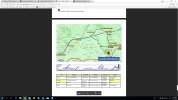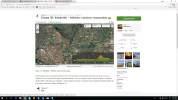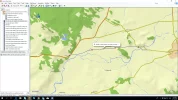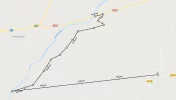That was the question for me a couple of weeks ago. https://www.caminodesantiago.me/community/threads/help-with-medellin-to-merida.55082/ If you look at the association guide, you will see the choice.

I learned that nearly everyone goes through Yelbes now, as I did. I had GPS tracks as I was walking alone, and my tracks followed the southern route through Yelbes. Leaving Yelbes, I was very glad to have the tracks because it is not well marked.
What I soon learned, though, was that whether you take the southern loop or the northern loop, you will wind up crossing the river on the bridge right at the point where the two alternatives merge. And then you will have a horrendous few kms on the side of an extremely busy national highway. I can't decide which was worse, the 3 kms from Cáceres to Casar de Cáceres or this stretch, but I am pretty sure this walk on the shoulder of the N-430 wins. Soon after Torrefresnada, the route goes off road, but those few kms are awful.
I know that Erik and a few forum members forged their own way straight west from Yelbes to the river. This wikiloc track did just that:

You can find the track at https://www.wikiloc.com/hiking-trails/etapa-18-medellin-merida-camino-mozarabe-9878755
The guy who posted this track says he was lucky to find a tractor to take him across the river, but that the river crossing could be very dicey. And if you can't cross the river, it's another 12 km back to take the bridge over.
This is what Erik said about it: There is a track, complete with occasional old markers, from Yelbes to San Pedro de Mérida which crosses the vast agricultural lands of the area and which parallels much of the engineering work that provides millions of litres of irrigation water to the rice, maize and tomatoes which dominate the fields. Crossing depends on river levels because fording the Búrdalo can only be achieved when they are low (which they were). Finding the ford was easy, crossing was not, as I elected in such shallow, calf-deep water to go barefoot.
So I guess the point of this post, other than that it serves as a diversion for a jet-lagged post-camino peregrina is that it seems that it would be a real risk to walk straight west to the river and then find it was impassable. Erik was lucky, but I guess I would recommend staying with the bridge crossing, whether you choose to go through Santa Amalia or Yelbes. But I would love to hear other opinions.
Buen camino, Laurie
p.s. To any of the other members of the Mozárabe mob, if you are not still walking, tell me what you did!

I learned that nearly everyone goes through Yelbes now, as I did. I had GPS tracks as I was walking alone, and my tracks followed the southern route through Yelbes. Leaving Yelbes, I was very glad to have the tracks because it is not well marked.
What I soon learned, though, was that whether you take the southern loop or the northern loop, you will wind up crossing the river on the bridge right at the point where the two alternatives merge. And then you will have a horrendous few kms on the side of an extremely busy national highway. I can't decide which was worse, the 3 kms from Cáceres to Casar de Cáceres or this stretch, but I am pretty sure this walk on the shoulder of the N-430 wins. Soon after Torrefresnada, the route goes off road, but those few kms are awful.
I know that Erik and a few forum members forged their own way straight west from Yelbes to the river. This wikiloc track did just that:

You can find the track at https://www.wikiloc.com/hiking-trails/etapa-18-medellin-merida-camino-mozarabe-9878755
The guy who posted this track says he was lucky to find a tractor to take him across the river, but that the river crossing could be very dicey. And if you can't cross the river, it's another 12 km back to take the bridge over.
This is what Erik said about it: There is a track, complete with occasional old markers, from Yelbes to San Pedro de Mérida which crosses the vast agricultural lands of the area and which parallels much of the engineering work that provides millions of litres of irrigation water to the rice, maize and tomatoes which dominate the fields. Crossing depends on river levels because fording the Búrdalo can only be achieved when they are low (which they were). Finding the ford was easy, crossing was not, as I elected in such shallow, calf-deep water to go barefoot.
So I guess the point of this post, other than that it serves as a diversion for a jet-lagged post-camino peregrina is that it seems that it would be a real risk to walk straight west to the river and then find it was impassable. Erik was lucky, but I guess I would recommend staying with the bridge crossing, whether you choose to go through Santa Amalia or Yelbes. But I would love to hear other opinions.
Buen camino, Laurie
p.s. To any of the other members of the Mozárabe mob, if you are not still walking, tell me what you did!



























